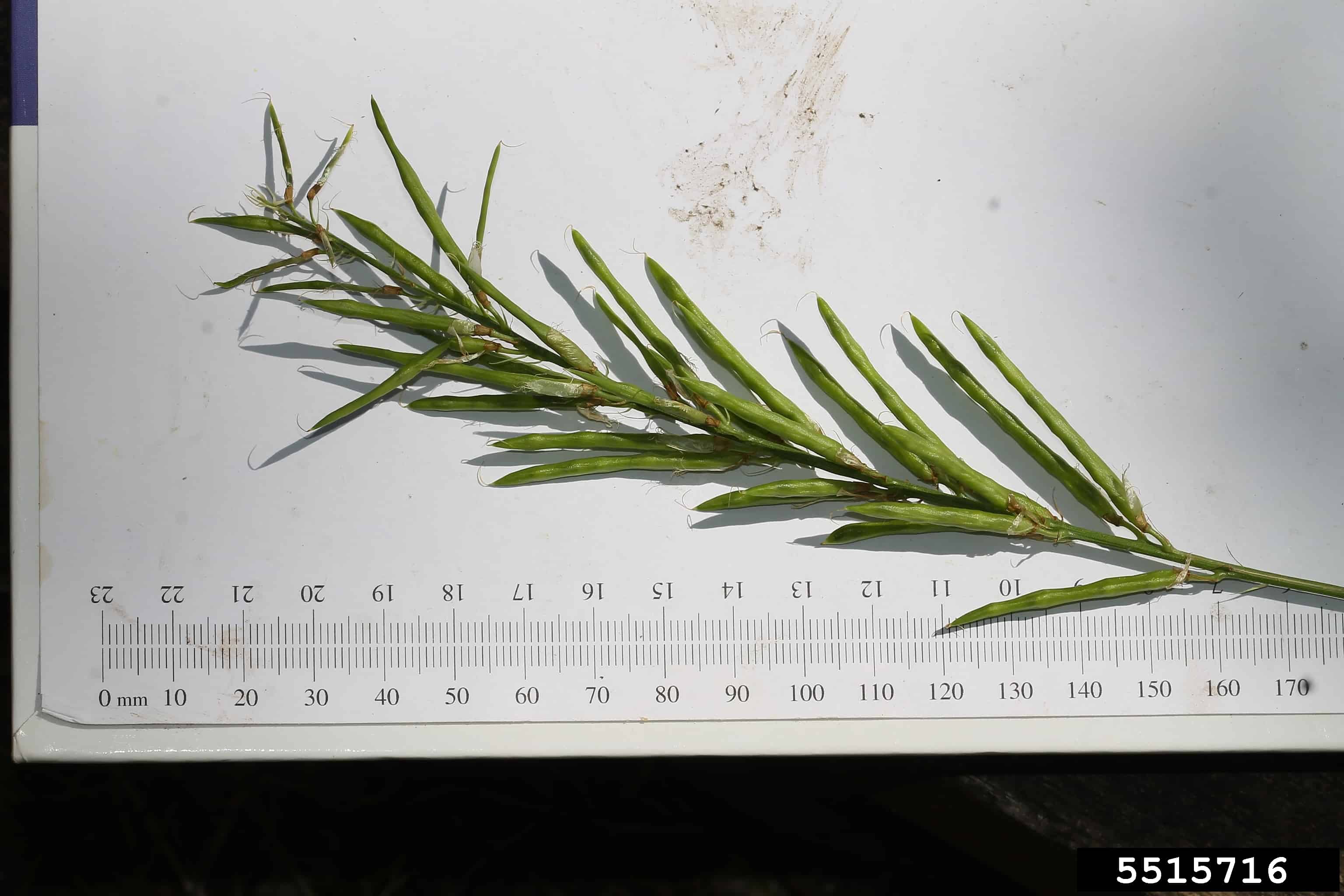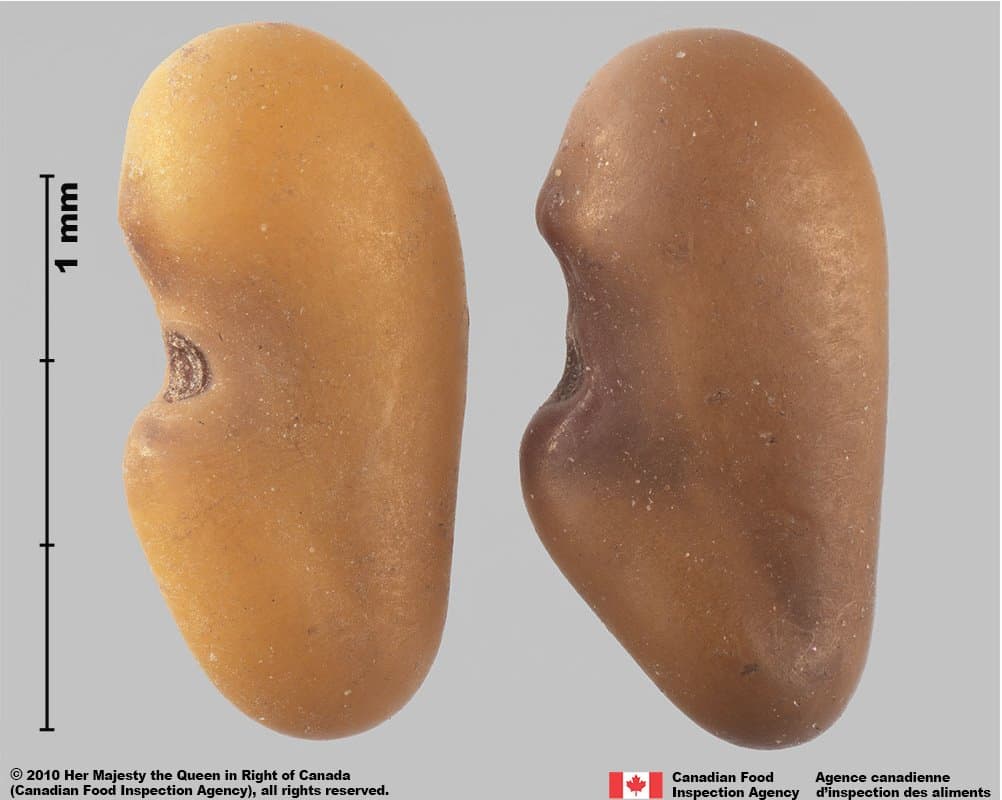Galega officinalis
Overview
Aperçu
Regulation :
Remarques Réglementation:
- CFIA Weed Seeds Order - Class 2: Primary Noxious Weed Seeds
- Quarantine lists of countries e.g. Mexico *may be updated without notice
- USA Federal Noxious Weed List
- USA Federal Noxious Weed Seed List
Regulation Notes:
Distribution :
Répartition :
Native to the Black Sea region in southeastern Europe and western Asia (Darbyshire et al. 2021), northern African populations may be native or naturalized (Darbyshire et al. 2021; CABI 2022). Introduced in Canada, China, the United States, Argentina, Chile and New Zealand (CABI 2022).
In Canada, the species occurs in Ontario and Quebec (Darbyshire 2003; Brouillet et al. 2010+). It has been collected at one site in Vancouver, British Columbia. However, it’s considered “a non-established” species and not considered to be part of the British Columbia flora”(Darbyshire et al. 2021). In the United States, this species is found mostly along the western and eastern coastal states, with a few inland such as Utah, Nebraska, and Oklahoma (Darbyshire et al. 2021).
Habitat and Crop Association :
Habitat et Cultures Associées :
Old fields, pastures, rangelands, grasslands, fencelines, shores, riverbanks, roadsides and disturbed areas (Darbyshire 2003; CABI 2022). Reported as a weed in Medicago sativa (alfalfa), vegetable crops and pastures (Whitson et al. 2000; Darbyshire et al. 2021).
Economic Use, cultivation area, and Weed Association :
Utilisation économique, zone de culture et association de mauvaises herbes :
Galega officinalis occurs in pastures in Europe, and the suitability as a green feed or hay is being investigated (Peiretti and Gai 2006).
Duration of Life Cycle :
Durée du cycle vital:
Perennial
Dispersal Unit Type :
Type d’unité de dispersion :
Seed
General Information
RENSEIGNEMENTS GÉNÉRAUX
Galega officinalis has a history of use as a bee plant, forage and medicinal plant (USDA-ARS 2022). It was initially introduced into Utah in the 1890s as a forage plant, but was found to contain an alkaloid toxic to livestock (Tingey 1971).
G. officinalis is being studied as a nutritious forage to supplement or replace expensive Glycine max (soybean) feed in Europe, like the related forage G. orientalis (Peiretti and Gai 2006). Chemicals, believed to be phytoestrogens, have been found to increase milk production in goats, cows and sheep (Peiretti and Gai 2006).
Since its introduction, G. officinalis has infested moist, waterlogged and acidic soils in pastures and old fields in Utah. It is proving difficult to eradicate in those habitats (Lasseigne 2003).
.
Galega officinalis infestation (Randy Westbrooks, Invasive Plant Control, Inc., Bugwood.org)
Identification
Identification
-
Legume
Size
- Legume length: 20 – 45 mm; width: 2 – 3 mm (Darbyshire et al. 2021)
Shape
- Legume cylindrical shaped, constricted between the seeds
Surface Texture
- Legume surface is longitudinally ridged and hairless
Colour
- Mature legumes are dull dark brown coloured
Other Features
- Immature legumes are shiny green coloured and smooth
-
Seed
Size
- Seed length*: 3.2 – 5.0 mm; width: 1.5 – 2.2 mm
*Note: minimum and maximum of 20 seeds in a normal range of this species using image measurement (ISMA 2020)
Shape
- Seed long oval to oblong with a notch at the hilum, compressed in edge view
Surface Texture
- Seed surface slightly roughened, no visible texture patterns
Colour
- Seeds are dull greenish-yellow, yellowish-brown or gray coloured
Other Features
Hilum and hilum area
- Hilum is round and surrounded by a ring of raised tissue
Other than hilum
- A short groove can be seen between radicle and cotyledons

Goat’s-rue (Galega officinalis) seeds




-
Embryo
Size
- Embryo fills the seed
Shape
- Embryo bent, with oval or D-shaped cotyledons
Endosperm
- Endosperm scant, nutritive tissue stored in the cotyledons
Other Features
- Cotyledons are fleshy and soft-textured
Identification Tips
CONSEILS POUR L’IDENTIFICATION
The similar species, Galega orientalis, is generally compared to G. officinalis, and both the plants and seeds can be distinguished. The seeds of G. officinalis are dull-coloured with a rounded ends and a distinct groove between the radicle and the cotyledons. G. orientalis seeds are generally shiny coloured with one pointed end and a slight or no furrow along the radicle.
Darbyshire et al. (2021) provides a comparison: G. officinalis plants lack rhizomes, have smaller leaflets, a sparsely hairy or smooth calyx, and hairless legumes held erect or spreading on the stem. These features differ in G. orientalis plants, which have rhizomes, larger leaflets, a densely hairy calyx, and hairy legumes reflexed on the stem.

Goat’s-rue (Galega officinalis) seed



Additional Botany Information
AUTRES RENSEIGNEMENTS BOTANIQUES
Flowers/Inflorescence
- The calyx is smooth or sparsely hairy (Darbyshire et al. 2021)
- The legumes are held in an erect or spreading position on the stem (Darbyshire et al. 2021)
Vegetative Features
- This species lacks rhizomes (Darbyshire et al. 2021)

Galega officinalis flowers (Rob Routledge, Sault College, Bugwood.org)



Similar Species
ESPÈCES SEMBLABLES
Similar species are based on a study of seed morphology of various species, and those with similar dispersal units are identified. The study is limited by physical specimen and literature availability at the time of examination, and possibly impacted by the subjectivity of the authors based on their knowledge and experience. Providing similar species information for seed identification is to make users aware of similarities that could possibly result in misidentification.
Galega orientalis Lam. (Oriental goat’s-rue)
Galega orientalis is generally used as a forage plant, for silage and to enrich grass pastures. Seeds are a similar size to G. officinalis (length*: 2.9 – 4.7 mm; width: 1.8 – 2.5 mm), and have a pointed end, glossy colour and a shallow or no radicle groove. G. officinalis seeds are dull coloured with curved ends and pronounced radicle groove.
*Note: minimum and maximum of 22 seeds in a normal range of this species using image measurement (ISMA 2020)
Click to select species
Cliquez pour sélectionner les espèces

Galega orientalis
Comparison Window
Fenêtre de comparaison
MAIN SPECIES
ESPÈCES PRINCIPALES
Galega officinalis

Galega officinalis
Fabaceae
Goat’s-rue (Galega officinalis) seeds
MAIN SPECIES
ESPÈCES PRINCIPALES
Galega officinalis

Galega officinalis
Fabaceae
Goat’s-rue (Galega officinalis) seeds
MAIN SPECIES
ESPÈCES PRINCIPALES
Galega officinalis

Galega officinalis
Fabaceae
Goat’s-rue (Galega officinalis) seed
MAIN SPECIES
ESPÈCES PRINCIPALES
Galega officinalis

Galega officinalis
Fabaceae
Goat’s-rue (Galega officinalis) seed, hilum view
SIMILAR SPECIES
ESPÈCES SEMBLABLES
Galega orientalis

Galega orientalis
Fabaceae
Oriental goat's-rue (Galega orientalis) seeds
SIMILAR SPECIES
ESPÈCES SEMBLABLES
Galega orientalis

Galega orientalis
Fabaceae
Oriental goat's-rue (Galega orientalis) seeds
SIMILAR SPECIES
ESPÈCES SEMBLABLES
Galega orientalis

Galega orientalis
Fabaceae
Oriental goat's-rue (Galega orientalis) seeds
SIMILAR SPECIES
ESPÈCES SEMBLABLES
Galega orientalis

Galega orientalis
Fabaceae
Oriental goat's-rue (Galega orientalis) seed
Need ID Help?
Besoin d’aide pour l’identification?
Reference(s)
Référence(s)
Brouillet, L., Coursol, F., Meades, S. J., Favreau, M., Anions, M., Bélisle, P. and Desmet, P. 2010+. VASCAN, the database of vascular plants of Canada. http://data.canadensys.net/vascan/ Accessed September 07, 2021.
Centre for Agriculture and Bioscience International (CABI). 2022. Invasive Species Compendium, CAB International, Wallingford, UK. https://www.cabidigitallibrary.org/journal/cabicompendium Accessed January 17, 2022.
Darbyshire, S. J. 2003. Inventory of Canadian Agricultural Weeds. Agriculture and Agri-Food Canada, Research Branch. Ottawa, ON.
Darbyshire, S.J., Francis, A., Bromfield, E.S.P. and Mechanda, S. 2021. Biology of Canadian Weeds XX. Galega officinalis L. Canadian Journal of Plant Science Online https://doi.org/10.1139/CJPS-2020-0327 Accessed January 24, 2022.
Global Biodiversity Information Facility (GBIF) Secretariat. 2022. https://doi.org/10.15468/39omei Accessed via https://www.gbif.org/species/2975667 Accessed December 29, 2022.
Government of Canada (GC). 2016. Canadian Weed Seeds Order. https://laws-lois.justice.gc.ca/eng/regulations/SOR-2016-93/page-2.html (English) https://laws-lois.justice.gc.ca/fra/reglements/DORS-2016-93/page-2.html (French)
International Seed Morphology Association (ISMA). 2020. Method for Seed Size Measurement. Version 1.0. ISMA Publication Guide.
Lasseigne, A. 2003. Galega sp. In: Invasive Plants of the Eastern United States, http://www.invasive.org/eastern/other/Galega.html Accessed May 30, 2016.
Peiretti, P.G. and Gai, F. 2006. Chemical composition, nutritive value, fatty acid and amino acid contents of Galega officinalis L. during its growth stage and in regrowth. Animal Feed Science and Technology 130: 257-267.
Tingey, D. C. 1971. Goatsrue, a potential forage crop, turned out to be a weed. Utah Science 32: 25-28.
Tropicos.org. 2022. Missouri Botanical Garden. https://tropicos.org Accessed March 11, 2022.
U.S. Department of Agriculture-Agricultural Research Services (USDA-ARS). 2022. Germplasm Resources Information Network (GRIN), https://npgsweb.ars-grin.gov/gringlobal/taxon/taxonomysimple.aspx Accessed January 17, 2022.
U.S. Department of Agriculture-Natural Resources Conservation Service (USDA-NRCS). 2022. The PLANTS Database. National Plant Data Team, Greensboro, NC USA. http://plants.usda.gov Accessed December 29, 2022.
Whitson, T. D., Burrill, L. C., Dewey, S. A., Cudney, D. W., Nelson, B. E., Lee, R. D. and Parker, R. 2000. Weeds of the West. 9th eds. Jackson, WY: Grand Teton Lithography. 324-325 pp.




